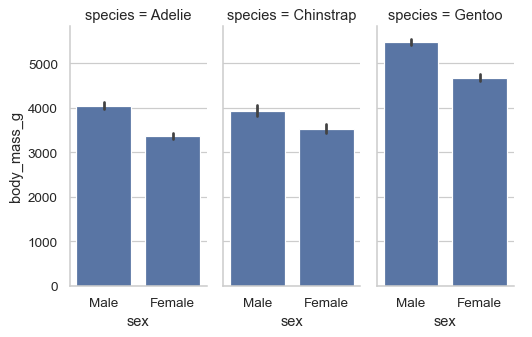seaborn.barplot#
- seaborn.barplot(data=None, *, x=None, y=None, hue=None, order=None, hue_order=None, estimator='mean', errorbar=('ci', 95), n_boot=1000, seed=None, units=None, weights=None, orient=None, color=None, palette=None, saturation=0.75, fill=True, hue_norm=None, width=0.8, dodge='auto', gap=0, log_scale=None, native_scale=False, formatter=None, legend='auto', capsize=0, err_kws=None, ci=<deprecated>, errcolor=<deprecated>, errwidth=<deprecated>, ax=None, **kwargs)#
Show point estimates and errors as rectangular bars.
A bar plot represents an aggregate or statistical estimate for a numeric variable with the height of each rectangle and indicates the uncertainty around that estimate using an error bar. Bar plots include 0 in the axis range, and they are a good choice when 0 is a meaningful value for the variable to take.
See the tutorial for more information.
Note
By default, this function treats one of the variables as categorical and draws data at ordinal positions (0, 1, … n) on the relevant axis. As of version 0.13.0, this can be disabled by setting
native_scale=True.- Parameters:
- dataDataFrame, Series, dict, array, or list of arrays
Dataset for plotting. If
xandyare absent, this is interpreted as wide-form. Otherwise it is expected to be long-form.- x, y, huenames of variables in
dataor vector data Inputs for plotting long-form data. See examples for interpretation.
- order, hue_orderlists of strings
Order to plot the categorical levels in; otherwise the levels are inferred from the data objects.
- estimatorstring or callable that maps vector -> scalar
Statistical function to estimate within each categorical bin.
- errorbarstring, (string, number) tuple, callable or None
Name of errorbar method (either “ci”, “pi”, “se”, or “sd”), or a tuple with a method name and a level parameter, or a function that maps from a vector to a (min, max) interval, or None to hide errorbar. See the errorbar tutorial for more information.
New in version v0.12.0.
- n_bootint
Number of bootstrap samples used to compute confidence intervals.
- seedint,
numpy.random.Generator, ornumpy.random.RandomState Seed or random number generator for reproducible bootstrapping.
- unitsname of variable in
dataor vector data Identifier of sampling units; used by the errorbar function to perform a multilevel bootstrap and account for repeated measures
- weightsname of variable in
dataor vector data Data values or column used to compute weighted statistics. Note that the use of weights may limit other statistical options.
New in version v0.13.1.
- orient“v” | “h” | “x” | “y”
Orientation of the plot (vertical or horizontal). This is usually inferred based on the type of the input variables, but it can be used to resolve ambiguity when both
xandyare numeric or when plotting wide-form data.Changed in version v0.13.0: Added ‘x’/’y’ as options, equivalent to ‘v’/’h’.
- colormatplotlib color
Single color for the elements in the plot.
- palettepalette name, list, or dict
Colors to use for the different levels of the
huevariable. Should be something that can be interpreted bycolor_palette(), or a dictionary mapping hue levels to matplotlib colors.- saturationfloat
Proportion of the original saturation to draw fill colors in. Large patches often look better with desaturated colors, but set this to
1if you want the colors to perfectly match the input values.- fillbool
If True, use a solid patch. Otherwise, draw as line art.
New in version v0.13.0.
- hue_normtuple or
matplotlib.colors.Normalizeobject Normalization in data units for colormap applied to the
huevariable when it is numeric. Not relevant ifhueis categorical.New in version v0.12.0.
- widthfloat
Width allotted to each element on the orient axis. When
native_scale=True, it is relative to the minimum distance between two values in the native scale.- dodge“auto” or bool
When hue mapping is used, whether elements should be narrowed and shifted along the orient axis to eliminate overlap. If
"auto", set toTruewhen the orient variable is crossed with the categorical variable orFalseotherwise.Changed in version 0.13.0: Added
"auto"mode as a new default.- gapfloat
Shrink on the orient axis by this factor to add a gap between dodged elements.
New in version 0.13.0.
- log_scalebool or number, or pair of bools or numbers
Set axis scale(s) to log. A single value sets the data axis for any numeric axes in the plot. A pair of values sets each axis independently. Numeric values are interpreted as the desired base (default 10). When
NoneorFalse, seaborn defers to the existing Axes scale.New in version v0.13.0.
- native_scalebool
When True, numeric or datetime values on the categorical axis will maintain their original scaling rather than being converted to fixed indices.
New in version v0.13.0.
- formattercallable
Function for converting categorical data into strings. Affects both grouping and tick labels.
New in version v0.13.0.
- legend“auto”, “brief”, “full”, or False
How to draw the legend. If “brief”, numeric
hueandsizevariables will be represented with a sample of evenly spaced values. If “full”, every group will get an entry in the legend. If “auto”, choose between brief or full representation based on number of levels. IfFalse, no legend data is added and no legend is drawn.New in version v0.13.0.
- capsizefloat
Width of the “caps” on error bars, relative to bar spacing.
- err_kwsdict
Parameters of
matplotlib.lines.Line2D, for the error bar artists.New in version v0.13.0.
- cifloat
Level of the confidence interval to show, in [0, 100].
Deprecated since version v0.12.0: Use
errorbar=("ci", ...).- errcolormatplotlib color
Color used for the error bar lines.
Deprecated since version 0.13.0: Use
err_kws={'color': ...}.- errwidthfloat
Thickness of error bar lines (and caps), in points.
Deprecated since version 0.13.0: Use
err_kws={'linewidth': ...}.- axmatplotlib Axes
Axes object to draw the plot onto, otherwise uses the current Axes.
- kwargskey, value mappings
Other parameters are passed through to
matplotlib.patches.Rectangle.
- Returns:
- axmatplotlib Axes
Returns the Axes object with the plot drawn onto it.
See also
Notes
For datasets where 0 is not a meaningful value, a
pointplot()will allow you to focus on differences between levels of one or more categorical variables.It is also important to keep in mind that a bar plot shows only the mean (or other aggregate) value, but it is often more informative to show the distribution of values at each level of the categorical variables. In those cases, approaches such as a
boxplot()orviolinplot()may be more appropriate.Examples
With long data, assign
xandyto group by a categorical variable and plot aggregated values, with confidence intervals:sns.barplot(penguins, x="island", y="body_mass_g")

Prior to v0.13.0, each bar would have a different color. To replicate this behavior, assign the grouping variable to
hueas well:sns.barplot(penguins, x="body_mass_g", y="island", hue="island", legend=False)
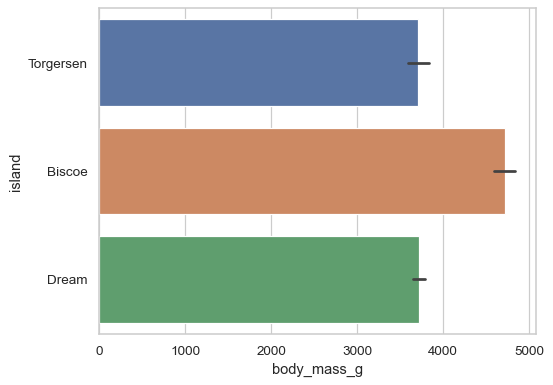
When plotting a “wide-form” dataframe, each column will be aggregated and represented as a bar:
flights_wide = flights.pivot(index="year", columns="month", values="passengers") sns.barplot(flights_wide)
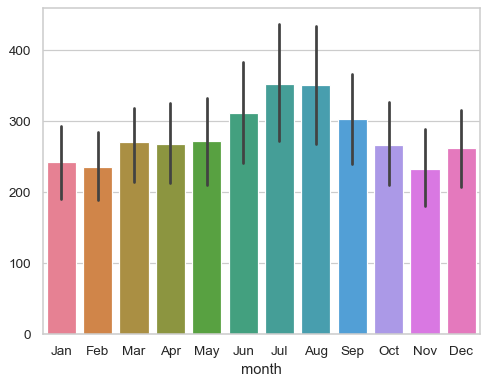
Passing only a series (or dict) will plot each of its values, using the index (or keys) to label the bars:
sns.barplot(flights_wide["Jun"])
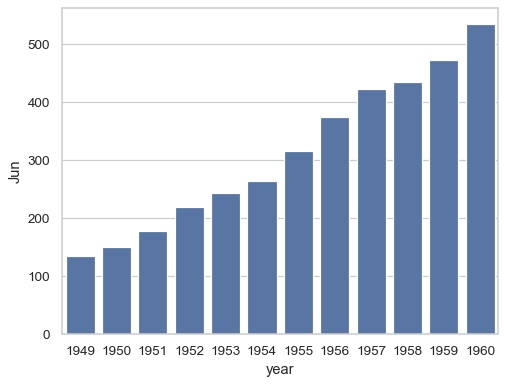
With long-form data, you can add a second layer of grouping with
hue:sns.barplot(penguins, x="island", y="body_mass_g", hue="sex")
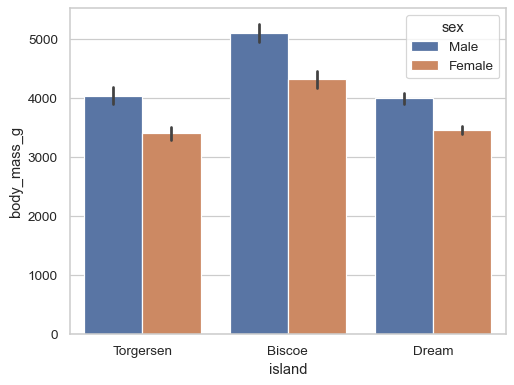
Use the error bars to show the standard deviation rather than a confidence interval:
sns.barplot(penguins, x="island", y="body_mass_g", errorbar="sd")
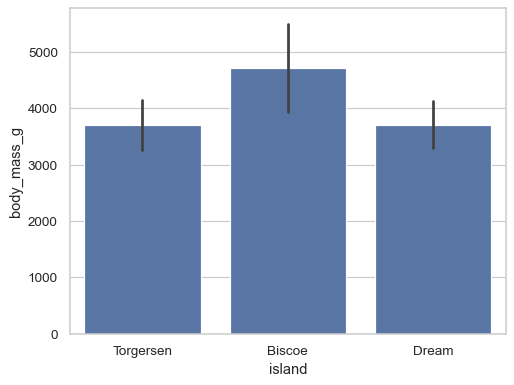
Use a different aggregation function and disable the error bars:
sns.barplot(flights, x="year", y="passengers", estimator="sum", errorbar=None)
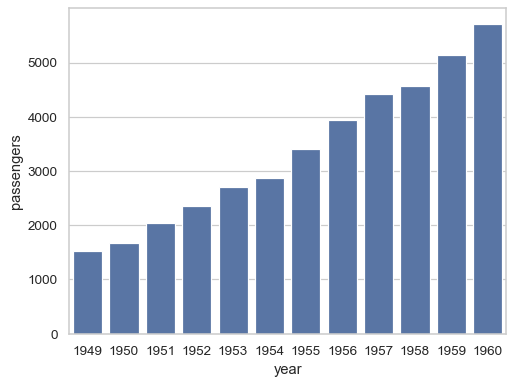
Add text labels with each bar’s value:
ax = sns.barplot(flights, x="year", y="passengers", estimator="sum", errorbar=None) ax.bar_label(ax.containers[0], fontsize=10);
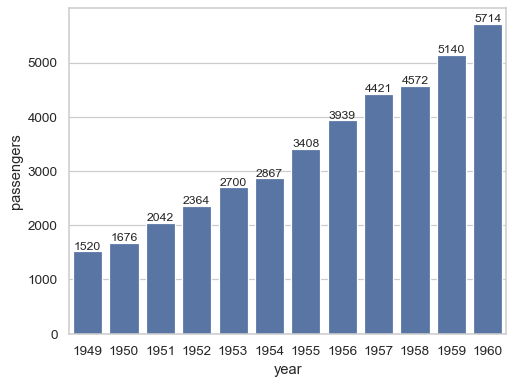
Preserve the original scaling of the grouping variable and add annotations in numeric coordinates:
ax = sns.barplot( flights, x="year", y="passengers", native_scale=True, estimator="sum", errorbar=None, ) ax.plot(1955, 3600, "*", markersize=10, color="r")
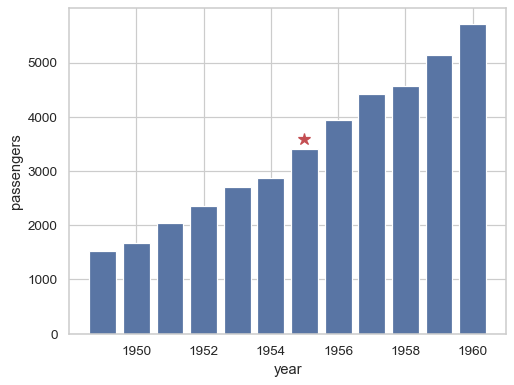
Use
orientto resolve ambiguity about which variable should group when both are numeric:sns.barplot(flights, x="passengers", y="year", orient="y")
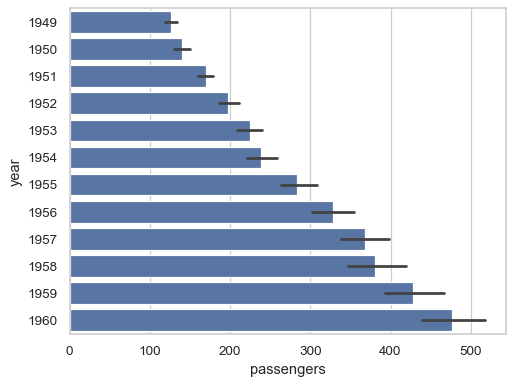
Customize the appearance of the plot using
matplotlib.patches.Rectangleandmatplotlib.lines.Line2Dkeyword arguments:sns.barplot( penguins, x="body_mass_g", y="island", errorbar=("pi", 50), capsize=.4, err_kws={"color": ".5", "linewidth": 2.5}, linewidth=2.5, edgecolor=".5", facecolor=(0, 0, 0, 0), )
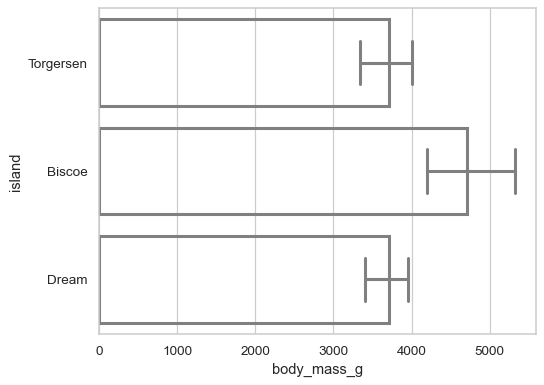
Use
catplot()to draw faceted bars, which is recommended over working directly withFacetGrid:sns.catplot( penguins, kind="bar", x="sex", y="body_mass_g", col="species", height=4, aspect=.5, )
